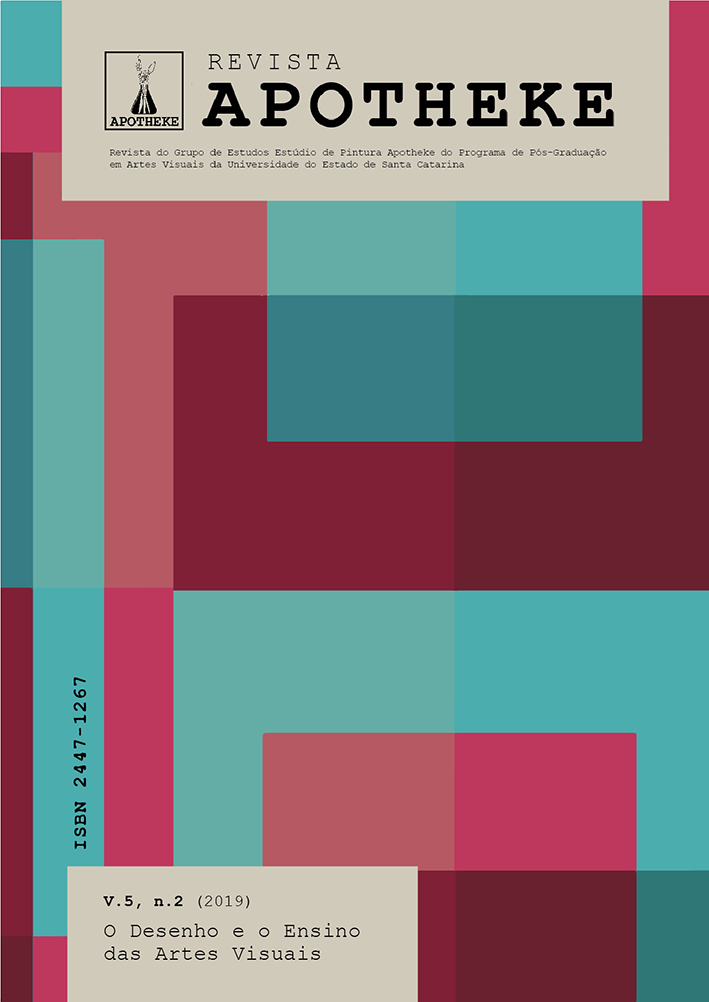O desenho na formação do profissional professor
DOI:
https://doi.org/10.5965/24471267522019067Keywords:
drawing, creativity, schoolAbstract
Assuming that drawing has always brought apprehension in the teaching-learning process, as it is associated with the “technique”, mastery and training, the objective of this article is to propose, through the description of an experience, a creative alternative to the teaching of drawing in order to contribute to/for teacher's education. Through sharing a realization of the degree in Visual Arts, drawing enters both asa process intertwining, and in parallel with research on birth or acquired anomalies, contrasting the concept of beauty aesthetic that is often characterized by the essential route. Still, I make theoretical considerations about the school space, about the teacher and its role in the scientific and social relations in the subject's formation, as well as about the significant contribution that this language can to the perception, reflection, and creativity in the student-reality-art relationship.
Downloads
References
ALENCAR, Eunice M. L. S. Criatividade. Edit. Edunb, Brasília, 1993.
COX, Maureen. Desenho da Criança. São Paulo: Martins Fontes, 2001.
DEWEY, John. A escola e a sociedade e A criança e o Currículo. Lisboa: Relógio D'Água Editores, 2002.
DEWEY, John. Arte como Experiência. São Paulo: Martins Fontes, 2010.
DUVE, Thierry de. Fazendo escola (ou refazendo-a?). Chapecó: Argos, 2011.
GARDNER, Howard. Arte, mente e cérebro: uma abordagem cognitiva da criatividade. Porto Alegre: Artes Médicas, 1999.
IAVELBERG,Rosa. Desenho na Educação Infantil. São Paulo: Melhoramentos, 2013.
HSUAN–AN, Tai. Desenho e organização bi e tridimensional da forma. Goiânia: UCG, 1997.
JESUS, Joaquim A. Luz. (In)Visibilidades: um estudo sobre o devir do professor-artista no ensino em artes visuais. Tese de doutoramento em Educação Artística,Faculdade de Belas Artes, Porto/Portugal, 2013.
JIMENEZ, Marc. O que é estética. São Leopoldo, Unisinos, 1999.
MÃE, Valter H. Mãe. O Paraíso são os outros. 2 a ed. Rio de Janeiro: Biblioteca azul, 2018.
OSTROWER, Fayga. Criatividade e processos de criação. Petrópolis: Vozes, 2014.
Downloads
Published
How to Cite
Issue
Section
License
Copyright (c) 2019 REVISTA APOTHEKE

This work is licensed under a Creative Commons Attribution-NonCommercial 4.0 International License.
Copyright and Licensing Policy
Authors of works submitted to Revista APOTHEKE authorize their publication in both print and digital formats exclusively for academic purposes. Reproduction is permitted, provided that the source is properly cited. Authors confirm the originality, authorship, and unpublished status of their manuscripts.
Articles published by the journal are freely available and intended for academic and non-commercial use only. All copyrights are transferred to the journal. The content of signed articles reflects the views of their respective authors and not the official position of Revista Apotheke. The author(s) agree to always cite the following reference when republishing or referring to the content originally published in Revista Apotheke:
“This article was originally published by Revista Apotheke in volume (insert volume), number (insert number), year (insert year), and is available at: http://www.revistas.udesc.br/index.php/APOTHEKE/index”
It is the sole responsibility of the authors to obtain written permission for the use of any material protected by copyright law included in their articles. Revista Apotheke is not responsible for copyright infringements committed by contributors.
Authors retain copyright and grant the journal the right of first publication, with the work licensed under a Creative Commons Attribution-NonCommercial License (CC BY-NC):
-
Attribution (BY): Licensees are allowed to copy, distribute, display, perform, and create derivative works, provided that proper credit is given to the author or licensor, in the manner specified.
-
NonCommercial (NC): Licensees may use the material only for non-commercial purposes.
After publication, authors retain the rights to their work and may republish the text.



